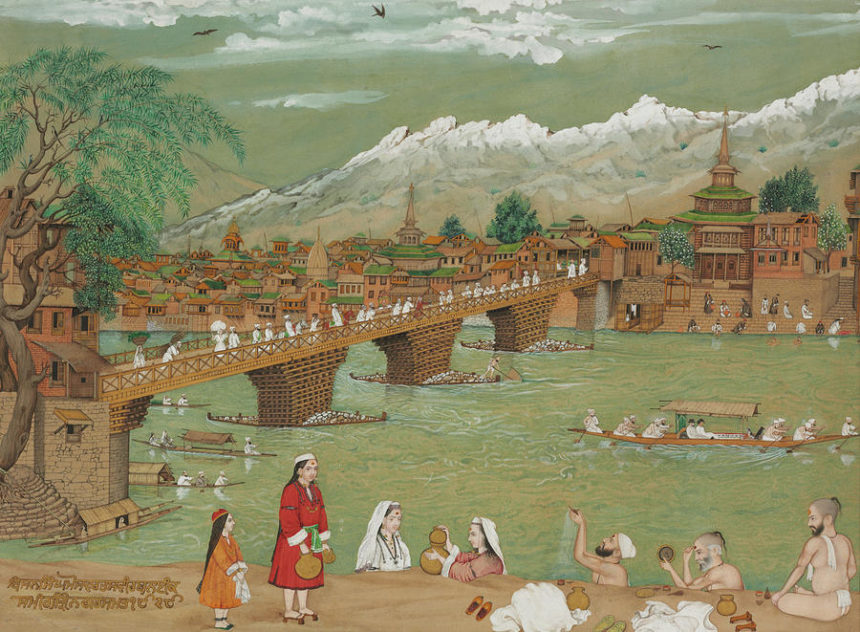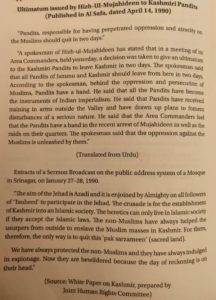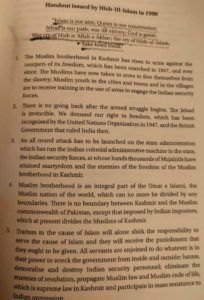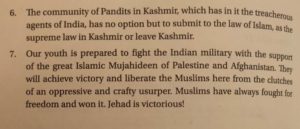The final exodus of Kashmiri Hindus from their homeland was complete, centuries after Islam put the holy land in its crosshairs.
Kashmir: An Overview of the Seven Exoduses of Hindus (Part 3)

Continued from Part 1 and Part 2
During Sikh and Dogra rule, the Hindus in Kashmir had a break from years of Islamic oppression. This was temporary. The rise of Islamic leaders started in the 1930s and the growth of Islamic terrorism ultimately resulted in a gruesome ethnic cleansing and the seventh exodus of Hindus out of the valley. This is the biggest scar on the Indian democracy that went unacknowledged for about 30 long years.
Despite a change in policy such as the Abrogation of Article 370 and 35A in 2019, and other methods to integrate Kashmir and resettle Hindus back into their homes, even the few remaining Hindus there continue to be targeted as before. One very recent example is the assassination of the Hindu businessman Akash Mehra for which the banned Muslim Janbaz Force took responsibility. The terror group is headed by Chaudhary Yasin, who is the vice-chairman of the United Jehad Council with Hizbul Mujahideen (HM) chief as the group’s chairman.
The Seventh Exodus
The rise of Kashmiri majoritarianism started under local Muslim parties along with the growth of Sheikh Abdullah who started as a communally charged rhetoric leader. Violence was unleashed on Pandits in 1931, to bring down Dogra rule. With the support of Nehru and the British, Sheikh Abdullah was successful in launching the Quit Kashmir Movement (May 10, 1946) against the Maharaja since he was the “Hindu ruler” of Kashmir. At the same time, Direct Action was launched by the Kashmir Muslim Conference, the sister organization of the Muslim League. (Jinnah called for ‘Direct Action’ on 16 August, 1946, demanding a divided India or a destroyed India. This had resulted in the widespread unleashing of terror by Muslims on Hindus.)
The period of Sheikh Abdullah’s second rule from 1977 to 1982, saw vigorous Islamization. Even Friday shows in cinemas were cancelled due to Jummah (Friday) prayers. Large funds were given to terror outfits, and their schools, and organizations by Pakistan and various Arab countries. Islamic revolution was openly called for. Mosques and Islamic institutes were built over government land and all methods were used to erase the pre-Islamic culture of Kashmir.
The communalized and anti-India Kashmiri politics provided fertile ground for Pakistan to pose as the “saviour” of Kashmiri Muslims from India. Amongst the intellectuals too, there were those against Sheikh Abdullah’s choice of Kashmir’s accession to India. These intellectuals got organized and played a big role in spreading disinformation.
The secularism of India was termed as anti-Islam and Pandits were made a target, being pro-India. Naturally, this included Muslim nationalists too. The All India Jammu and Kashmir Muslim Conference – the proxy of the Muslim League in the State, supported Pakistan in its attempt to grab Kashmir in 1947-48, and a chunk of the Muslim middle class worked along with Pakistani interest.
In 1970, there was a violent agitation due to a book called Book of Knowledge in the library of a college in Anantnag as it had an image of the Prophet Mohammad (considered blasphemy in Islam). The book was removed by the Union but four people had already died in the violence. While the seventies seemed relatively peaceful, slowly the radical elements began to gain momentum once again in the light of certain international developments, and Pakistan’s collaboration with radical Islamic and anti-India elements in Kashmir. Local youth began to be trained by Pakistan and heavy radicalization of local Muslims started in the Madrassas. Tablighi Jammat, Jamat-e-Islami (JeI), Ahle Hadis and Salafists were immersed in an intensive local campaign.
After Sheikh Abdullah started the political career of his son, Farooq Abdullah, who had intimate ties with the Jammu and Kashmir Liberation Front (JKLF) and Pakistan who nurtured the anti-India sentiment and communal agendas, Kashmir became the breeding ground of terrorists which included Sikh Khalistani terrorists. On the death of Brindranwale (1984), agitated Khalistanis targeted the Hindu areas and the Hanuman Mandir – 15 people were killed.
Students of Kashmir University were encouraged to strengthen their Islamic identity, and Farooq worked towards promoting Muslim unity. He won most elections through illegal practices and the Congress office was also set to fire by National Conference (NC) workers. Slogans of “Pakistan zindabad” were shouted openly in cricket matches while the CM Farooq Abdullah watched silently. Seeing this growing situation of his anti-India and anti-Congress stance, Indira Gandhi, with the help of Farooq’s brother-in-law G.M.Shah, created defections in the NC and succeeded in installing the latter as the CM in 1985. G.M.Shah’s period was that of misrule, bomb blasts and endless curfews.
In February 1986, riots broke out in Kashmir against the minuscule minority of Kashmiri Pandits, particularly in the district of Anantnag. The fundamentalists went on a spree of loot and arson and desecration of temples to terrorize the helpless Pandits (28 were killed). From 1986 onwards, there is a long list of Hindu temples and religious centres that were destroyed and looted. Col. Tikoo has given a list of temples vandalized in the disturbance of February 1986 itself (the count is 52 temples), in his book. This includes prominent temples in Srinagar, Anantnag, Badgam, Kupwara, Rajouri and Baramulla districts.
Governor’s Rule, under Jagmohan, was imposed in March 1986. It was a temporary respite and break from misrule under Farooq and GM Shah. Bold anti-corruption steps were taken, the government was made accountable, and immense development work was done. This was welcomed by the people, however, it threatened Islamic and other vested interests. The corrupt politicians, bureaucrats, drug peddlers, and communal elements began to churn up a movement against the Governor.
In the meanwhile, Farooq Abdullah and Rajiv Gandhi’s deep friendship resulted in the partnering of NC with INC. During this time the Muslim United Front was born with the joining together of sectarian groups of the NC’s opposition. This threatened the NC-Congress alliance, which then indulged in malpractices during elections and won. People were shocked by the results that were followed by bloodshed, arrests, and torture of the Muslim United Front members who protested.
These actions by the NC-Congress set the stage for the two-decade-long turbulence in the Valley that followed. Congress represented “India”, supposedly the cause for all of Kashmir’s problems. Shooting and arrests of the Muslim United Front members post the corrupt election counting threw the Valley into flames as the youth and party members took up arms that Pakistan supplied. In 1989, Farooq Abdullah released 23 top terrorists. This was a shock to the police officers who were risking their lives to arrest them. The officers were threatened by the terrorists who got the silent support of the government.
The National Flag was burnt right in front of the police and Pakistan’s independence day was celebrated on 14th while on 15 August 1989 Indian flags were burnt and black-out was enforced by terrorists in the evening. Bomb blasts, attacks on buses, central government officers became common. It was only at the Ganpathyar temple in Srinagar that the Indian flag could be hoisted since the Hindus had sought police protection.
The CRPF watched helplessly as they did not get any orders from local police officers without which they could not act. Schools were burnt, bars were shut in hotels and clubs, the liquor trade was closed down, and control was in the hands of the terrorists. Even the press had to give full support to further their terrorist operations and help them gain popularity.
Large-scale corruption, nepotism, lack of accountability, unresponsiveness, and misrule became the characteristic features of Farooq Abdullah’s leadership. All policies were aimed at favouring Kashmiri Muslims. Even people in the government collaborated with terrorists. In 1989, Mufti Mohammad Syed, then the Home Minister of India had his daughter kidnapped. The demand of terrorists who kidnapped her was the release of 5 JKLF cadres. People celebrated the release of terrorists and anti-India slogans echoed in Kashmir.
The ISI’s (Inter-Services Intelligence) waging of jihad in Afghanistan and the victory of the Mujahideen trained by ISI, the birth of Al Qaeda, and the creation of the Taliban are some important developments in this time, in terms of the growth of Islamic outfits in the surrounding regions. ISI declared war on India and gave full support through the supply of weapons etc. Kashmir was used as a training ground for terrorists. The resources of ISI are heavily used for operations in J&K, Afghanistan, northeast India, and Punjab. It manages training, weapons, planning, intelligence, and implementation of all terror operations.
Kashmiri Hindus and other non-Muslims were the kafirs – they were vulnerable and unprotected even by the secular Indian State. Article 370 and 35A further facilitated Islamist and separatist agendas and the desire to wipe out the kafirs. This would break ties with India and would also be a noble cause for jihadis.
The death of Indira Gandhi in 1984 and poor central and state leadership, international preoccupation with Afghanistan, Russia moving towards its break up and giving rise to many Islamic countries, and US support to Pakistan, communal politics and local support by Muslim communal leaders & parties, provided favourable conditions for Pakistan to launch their Operation.
With the aim of creating an Islamic State, under the Pakistani leadership of Zia-ul-Haque, ‘Operation Topac’ (formulated by the ISI) was launched in 1988. Fomenting insurgency in the state and infiltration of trained and well-equipped jihadis were the highlights of this operation.
In the first phase, the JKLF started the agitation in the valley with the slogan of ‘Azadi’ that was welcomed by the larger population. A large number of Kashmiri youth were recruited for jihad and sent to several sophisticated military training camps across the LoC (Line of Control). December 1989 onwards, well-planned killings, kidnappings, and ransacking commenced in J&K. It was a mighty insurgency in the name of “liberation” and the unleashing of an 18-month terror campaign was announced by Amanullah Khan who headed the JKLF.
Large scale Islamic indoctrination of locals in the state started and inspiration was drawn from Khomeini’s revolution in Iran (Ayatollah Ruhollah Khomeini was the architect of the Iranian Revolution and the first leader of the Islamic Republic established in 1979). Al-Jehad and JeI were accepted locally and society was radicalized enough already by 1984 to permit the quick rise of Kashmir Liberation Front (KLF), Mahaz-e-Azadi, etc., for an Islamic revolution.
Between 1989-1990, roughly 25000 Kashmiri youth were trained for jihad by Pakistan, according to intelligence agencies. Many were inspired by the writings of Abd Al-Salam Faraj (an Egyptian Islamist and theorist) in Al Farida Al Ghaiba (The Neglected Duty) and joined the jihad against non-Muslims. For Faraj, there is no co-existence with other religions, except if non-Muslims pay jaziya.
Former Director of J&K Police, Sri M.M.Khajooria stated-
“Mischief of the summer of 1989 started with serving notice to the prominent members of the minority community to quit Kashmir. The letter said, ‘We order you to leave Kashmir immediately, otherwise your children will be harmed- we are not scaring you but this land is only for Muslims, and is the land of Allah. Sikhs and Hindus cannot stay here.’ The threatening note ended with a warning, ‘If you do not obey, we will start with your children. Kashmir Liberation Zindabad.’”
Selective killings of prominent Pandits were done. To instil fear, Hindus were subjected to brutal torture before they were murdered. On September 14, 1989, JKLF did the first assassination and the target was Sri Tika Lal Taploo of BJP, who was killed in cold blood in broad daylight. The killers were not caught despite several eyewitnesses. This trend continued throughout the genocide. Similarly, uncountable others were killed and women were subjected to the most horrific rapes.
Around the end of 1989, Syed Ali Shah Geelani – a politically powerful leader of Jel, brought in several strong Islamic, anti-national leaders under his wing, and started rapid militarization of cadres for achieving the goal of Islamization. He was in favour of a merger with Pakistan. A full-fledged armed program was launched. Hizbul Mujahideen (Party of Holy Fighters) was created by him, and brought under the command of Master Ahsan Dar. Jel of J&K and PoK gave full support to HM.
Political leaders either went underground or ended political associations. The police and administration were in a similar state. A staunch Islamic code of conduct was enforced. JeI run schools replaced private and government ones that were burnt down. Even the names of various places were changed in order to completely wipe out the pre-Islamic history of Kashmir. On January 4, 1990, Aftab and Al Safa – local newspapers, published a press release given by HM asking Pandits to leave the Valley. Mosques made such announcements too.

Images- Kashmir: Its Aborigines and their Exodus by Colonel Tej. K.Tikoo, Ph.D.
The night of January 19, 1990, is remembered as the longest and most horrific night for the Hindu minority. The zealous Muslims unleashed a well-orchestrated terror operation. Streets echoed with their marches and deafening Islamic war cries. Innumerable local Muslims deceitfully facilitated the bone-chilling murders of their neighbours, friends, and associates. Even now, uncountable murderers and conspirers roam free in Kashmir. Many non-fanatic Muslims took to Wahabi Islam succumbing to fear while the secular or nationalist Muslims had to face the same fate as Hindus. The already brutalized and marginalized minority faced a planned massacre.
Non-Muslims were given a choice to convert to Islam, leave, or get killed. As can be observed, this was the same pattern followed through the middle ages when the six exoduses took place.


Col. Tikoo writes,
“These killings took place in the first phase of militancy, dominated by Jammu Kashmir Liberation Front (JKLF), which was made up entirely of local youth.”
It is shocking to learn about the tortures people were put to and the merciless ways in which they were murdered. There were dehumanizing rapes, chopping off of limbs, gouging of eyes, stitching of lips, nailing of tilak marks, and other gruesome tortures that were done by the terrorists before killing victims. Many bodies were found floating in the Jhelum and hanging on trees. The blood-curdling rape and killing of a school teacher Ms Girija Tikoo in 1990, is just one such example.
As per the report of the Panun Kashmir Movement, the number of Kashmiri Pandits killed till October 1990, was 319. B.N.Nisar, the editor of Kashyap Vani, presented a list of the names of 765 Kashmiri Pandits who were massacred between 1986 and April 1997. His report also details the type of killings – like rape, strangulation, hanging, brutal killings, bomb blasts, etc. According to the report by the Ministry of Home Affairs, Govt. of India, there were a total of 61935 incidents between 1990 and January 2005. It is estimated that 12,542 civilians were killed and 4116, security forces. Properties of Hindus were grabbed, houses looted and plundered and many localities were charred. This period also saw the destruction and vandalizing of several temples, the details of which will be beyond the scope of this essay.
Later, smaller rival outfits that did not support a merger with Pakistan were curbed. Previously given support to JKLF was soon withdrawn by Pakistan and HM took the lead with a pro-Pakistani stand, rather than ‘Azadi’. Geelani also formed the Hurriyat Conference which had several hardliners in given key posts. Between 1990-93, there were approximately a hundred militant organizations in Kashmir.
Pakistan was deeply involved at all levels and despite warnings about this, the Government of India failed to take any steps leading to the second phase of Operation Topac in 1991. By this time, the ISI had taken full control over several militant organizations for launching joint operations. Syed Sallah-ud-Din became the Supreme Commander of HM and by February 1995, he shifted base to Muzaffarabad where he operates as head of the United Jehad Council.
Often, terror attacks were carried out by disguising themselves as Indian police or army to create more anger and resentment towards India, in the eyes of locals. Operation Topac of Pakistan aimed to, with the local support of radicalized Kashmiri Muslims, complete the Islamization of Kashmir and unite the state with Pakistan. Kashmir would then become Dar-ul-Islam (a territory where Islam dominates) where non-Muslims, who stayed back and did not convert, would be reduced to the status of Dhimmies.
The period from 1989-90 witnessed the seventh horrific exodus of Hindus as well as some Sikhs, out of Kashmir. Over 3.5 ~ 5 lakh were forced to flee from their homes. Basic human rights were denied. The pathetic state of refugees and the unbelievable hardships they continue to endure would require another essay altogether. About two generations have passed away in the struggle for seeking justice and chasing the dream of going back home. Post-partition, this was the single largest forced exodus of a particular ethnicity. Kashmiri Hindus became refugees in their own secular, democratic country. It is 2021, and the Hindus are yet to reclaim their home and sacred spaces in Kashmir where bloodshed continues in the name of religion.
References:-
- Narender Sehgal, “Converted Kashmir, A Bitter Saga of Religious Conversion,” Utpal Publications, Printed at Kiran Mudran Kendra, New Delhi, 1994, ISBN-81-85217-06-8
- S.S Toshkhani, Mr.B.L.Kaul, Prof.M.L.Raina (1990), “Kashmir: The Crisis in Perspective”, Political History of Kashmir, Kashmiri Pandit Network
- Colonel Tej K. Tikoo (Ph.D.) –Kashmir: Its Aborigines and their Exodus (Revised Edition), Lancer Publishers & Distributors, Printed at Thomas Press, New Delhi, 2020, ISBN-10: 1-935501-34-8
- Justice S.N. Aggarwal (Former Judge Punjab & Harayana High Court- Nehru’s Himalayan Blunders: The Accession of Jammu and Kashmir, Garuda Prakashan Private Ltd., Gurugram, First Published in 2019, ISBN:978-1-942426-13-4
- India Today, 1990 “List of terrorists released by Farooq Abdullah govt between July and December 1989”, Issue date April 30, 1990, Updated: October 10, 2013.
- *Report on the Impact of Migration on the Socio-economic Conditions of Kashmiri Displaced People, Jammu and Kashmir Centre for Minority Studies.
- Ministry of Home Affairs, Government of India, Annual Report 2004-2005, Department of Internal Security, Jammu & Kashmir Affairs, Border Management, State and Home, New Delhi

Leave a Reply